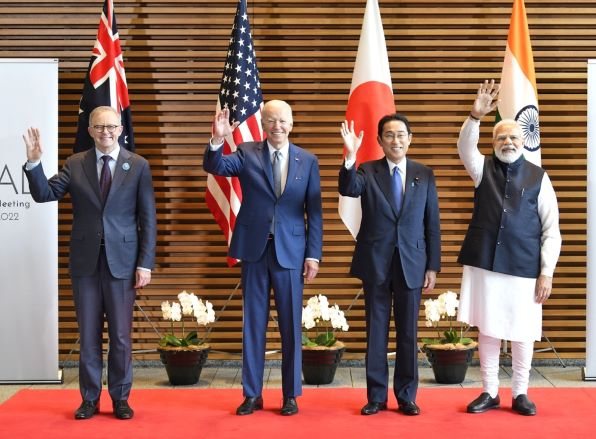US president Joe Biden recently visited Asia in an effort to strengthen relationships in the region, most notably meeting with leaders of the “Quad” alliance of America, Japan, India and Australia. This group of like-minded states represents a 21st-century diplomatic mechanism which is growing in importance in lieu of an Asian Nato.
Biden’s trip coincided with a visit by Chinese foreign minister Wang Yi to Fiji, as part of Beijing’s so-far unsuccessful attempts to gather a coalition of Pacific Island states. China has been wooing nations in the Pacific for some time, as it attempts to expand its diplomatic reach. Most notably, a security deal with the Solomon Islands might open the door to Chinese military presence there.
All these efforts illustrate the kind of reshaped global order that we can expect to see in the future. The new security landscape is of pacts between small numbers of states that produce powerful security groupings with quite specific focus in deterring other great powers. Welcome to a new era of micro alliances in international politics.
The Quad has its roots in cooperative disaster response efforts in the aftermath of the 2004 Boxing Day tsunami, but it has evolved in recent years to become more about security. Although the process has stuttered at various points, it has returned to relevance, particularly as a convenient vehicle for countering China’s Belt and Road Initiative (BRI) through which the country is using international investment to build influence across Eurasia and Africa.
The Quad has now pledged to extend more than US$50 billion (£39.7 billion) in infrastructure aid and investment in the Indo-Pacific over the next five years to counter China’s economic clout in the region.
Each of the member states has bilateral issues with China, including territorial disputes, historically rooted tensions and spiky diplomatic relations. But the core motivation for its continuance and promotion is the realpolitik consideration of constraining the People’s Republic. This was confirmed in a 2019 speech by the then US secretary of state, Michael Pompeo, who described the group’s role as “ensuring that China retains only its proper place in the world”.
China has been increasingly assertive in recent years, especially with regard to the South China Sea, but also in terms of its economic policies such as the BRI and its occasionally bellicose diplomatic rhetoric. This has prompted states from across the Asia-Pacific region – and beyond – to rethink the previous policies that focused more on engagement with China than containment.
In this light, the Quad can be seen as a demonstration of the willingness of the US and its allies to respond more assertively in defending their position and interests in the region. This has not gone unnoticed in China. The Global Times, a state-owned tabloid newspaper, has repeatedly referred to the Quad as the “sinister gang of Indo-Pacific to contain China”.
Other alliances
The underlying principle of the Quad has parallels with Aukus, a security pact between Australia, the United Kingdom and the US. This was announced in September 2021 with the initial purpose of helping Australia develop nuclear-powered submarines.
There is also the “Five Eyes”, an intelligence-sharing arrangement among the US, the UK, Canada, Australia and New Zealand. The Quad’s fundamental difference is the presence of two Asian powers that are eager for support to balance against China on their doorstep.
It is important to highlight that the Quad’s prominence is increasing in the context of almost complete silence from the Association of Southeast Asian Nations (Asean). This is despite efforts to convince the ten Asean member states that the Quad provides opportunities beyond security, such as the already-mentioned investment pledge.
New world order
Looking from a more macro perspective, the Quad – together with Aukus, Five Eyes and the Indo-Pacific Economic Framework for Prosperity (IPEF), a regional economic partnership – offers a big picture of the overall US strategy to contain China in the coming decades.
We are not yet in a new cold war, but we no longer live in a unipolar world dominated by a hegemonic US. This reshaping of the international order was already underway, driven by the increasing assertiveness of China. But Russia’s assault on Ukraine, accompanied by Beijing’s “no limits” cooperation with Moscow, has hastened and exacerbated the drawing of lines across the globe.
Biden’s secretary of state, Antony Blinken, explicitly confirmed this focus in a recent speech:
Even as President Putin’s war continues, we will remain focused on the most serious long-term challenge to the international order – and that is the one posed by the People’s Republic of China.
We should not expect imminent direct conflict but it is clear that global strategic competition between the US and China is intensifying. The Quad is just the most recent example of how the teams are lining up.
Written by
Ed Griffit, Deputy Head, School of Humanities, Language & Global Studies, University of Central Lancashire and Moises de Souza, Course Leader International Relations BA Programme, University of Central Lancashire
Sourced by: Queenie Nair
This Article was first published in The Conversation and is republished under the Creative Commons Licence



